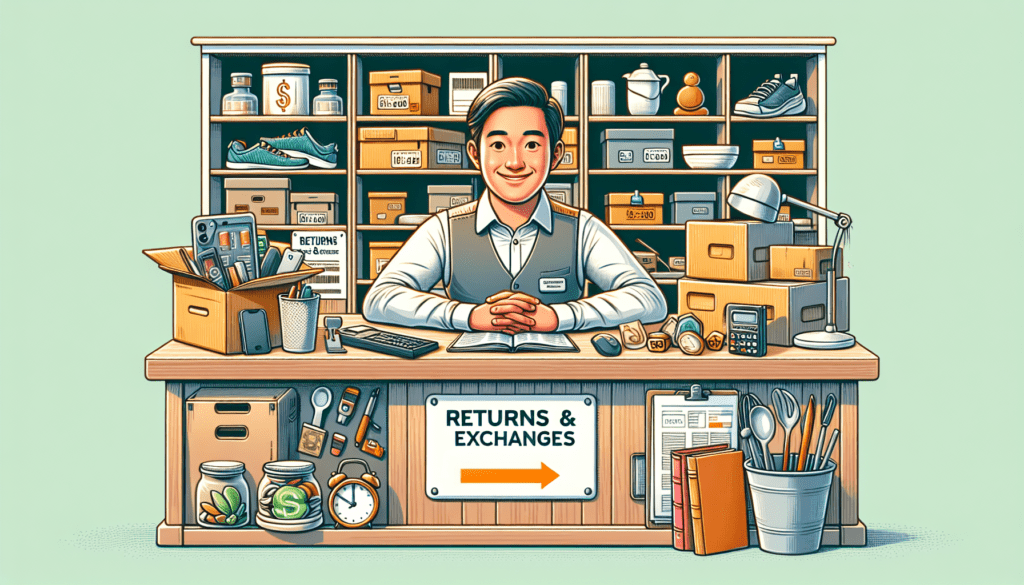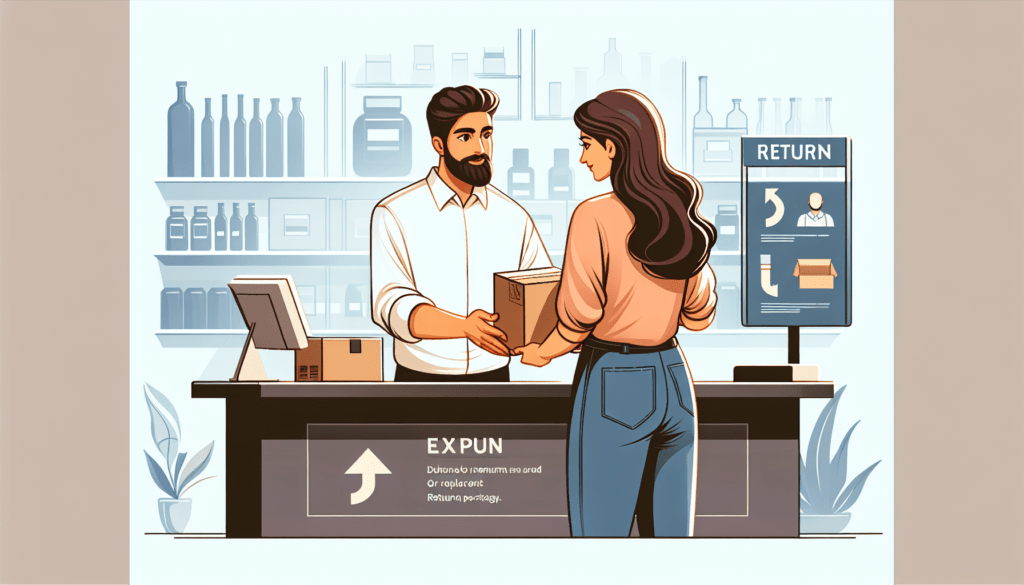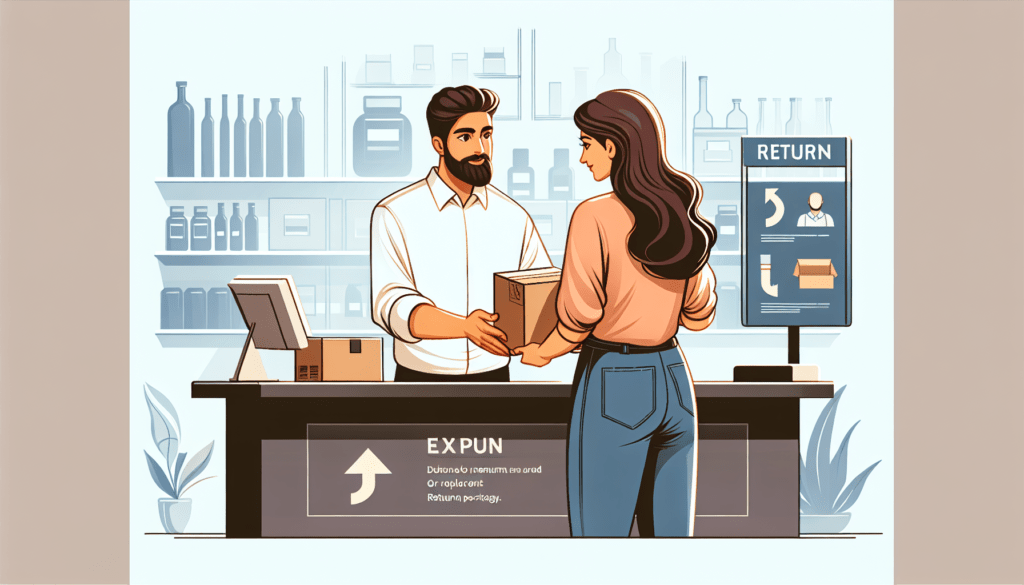If you find yourself unhappy with a product you purchased, don’t worry! There are plenty of ways to exchange it hassle-free. Whether it’s the wrong size, color, or simply doesn’t meet your expectations, this article will guide you through the best methods for exchanging a product. From returning it to the store to contacting customer service, you’ll learn all the tips and tricks to ensure a smooth and successful exchange process. So, before you stress about being stuck with something you don’t want, read on to discover the best ways to exchange a product.
Reviewing the return policy
When you find yourself needing to exchange a product, it’s essential to start by reviewing the store’s return policy. Each store may have different rules and regulations regarding exchanges, so it’s important to familiarize yourself with these guidelines. Look for information on the time frame for returns, conditions for returning a product, and any specific requirements for exchanging different types of items. By understanding the store’s return policy upfront, you can ensure a smoother exchange process and avoid any unexpected surprises.
Checking the time frame for returns
One of the key aspects to consider when exchanging a product is the time frame allowed for returns. Most stores have a specific period within which you can make an exchange, and it’s crucial to adhere to this timeframe. Take note of the date of purchase and calculate how many days you have to return the item. Some stores may have extended return policies during holiday seasons, so it’s worth checking if any special conditions apply during these times. Being aware of the time frame for returns will help ensure that you don’t miss the window to exchange your product.
Understanding the conditions for returning a product
Before initiating an exchange, it’s vital to understand the conditions that must be met for returning a product. Some stores may require the item to be in its original condition, while others may allow exchanges for opened or used products. Additionally, certain products, such as perishable items or personalized goods, may have specific restrictions on returns. By familiarizing yourself with the specific conditions for returning a product, you can ensure that your item is eligible for exchange and avoid any potential complications.
Ensuring the product is eligible for return
Once you have reviewed the return policy and understood the conditions, it’s time to ensure that your product is eligible for return. Carefully inspect the item for any signs of damage or use that may invalidate the return. Make sure all original packaging, accessories, and labels are intact. If possible, gather any proof of purchase, such as receipts or order confirmations, to provide evidence of your transaction. By ensuring that your product meets the store’s eligibility requirements, you can proceed confidently with the exchange process.
Preparing the product for return
Before taking your product back to the store or initiating an online return, it’s essential to prepare the item properly for return. If the item is fragile or prone to damage, consider wrapping it securely in bubble wrap or using protective packaging materials. Remove any personal or sensitive information if necessary. Pay attention to any specific packaging instructions provided by the store, such as placing the item in its original box or including additional documentation. Properly preparing your product for return will help ensure its safe transportation and facilitate a smooth exchange process.
Confirming the availability of in-store exchanges
If you prefer to exchange the product in-store, it’s important to confirm the availability of in-store exchanges. Not all stores may offer this option, particularly for certain types of products or if the store has a separate returns department. Check the store’s website or contact customer service to inquire about their in-store exchange policy. Knowing whether in-store exchanges are accepted will help you plan your visit accordingly and avoid any unnecessary trips.
Gathering the necessary documentation
When exchanging a product in-store, it’s crucial to gather the necessary documentation to facilitate the process. Typically, you will need to bring the product itself along with proof of purchase, such as the original receipt or order confirmation. Additional documentation, such as warranty cards or product registration forms, may also be required for certain items. Make sure to gather all the necessary paperwork before heading to the store to avoid any delays or complications during the exchange.
Packaging the product properly
In order to exchange the product in-store, it’s important to package it properly for transportation. Place the item in its original packaging, if available, to prevent any damage during transit. If the original packaging is not available or suitable, consider using a sturdy box or packaging materials to secure the product. By packaging the item properly, you ensure that it remains protected and ready for exchange when you visit the store.
Visiting the store during business hours
When exchanging a product in-store, it’s crucial to visit the store during their business hours. Check the store’s website or contact customer service to confirm their operating hours. Arriving within the designated hours ensures that the store’s personnel are available to process your exchange and address any questions or concerns you may have. It also helps to avoid any potential disappointment if the store is closed or unable to process exchanges outside of their regular hours.
Presenting the product and proof of purchase
Once you have arrived at the store during business hours, it’s time to present the product and proof of purchase to the store personnel. Clearly explain your reason for the exchange and provide any relevant details or documentation. Be prepared to answer any questions or provide additional information that may be requested by the store employees. By presenting the product and proof of purchase in a clear and organized manner, you help expedite the exchange process and increase the chances of a successful resolution.
Reviewing the online exchange process
If you opt to exchange a product online, it’s crucial to review the store’s online exchange process. Every store may have different procedures in place, so it’s important to familiarize yourself with their specific requirements. Look for information on how to initiate the exchange, any forms or documents that need to be filled out, and any fees or charges associated with the online exchange process. Understanding the online exchange process will help you navigate through the necessary steps and ensure a smooth exchange experience.
Contacting customer service
When initiating an online exchange, it’s recommended to contact customer service for assistance. Most online stores have dedicated support teams that can provide guidance and answer any questions you may have regarding the exchange process. Reach out to customer service through the designated channels, such as phone, email, or online chat, and explain your situation clearly and concisely. The customer service team will be able to guide you on the specific steps and procedures to follow for your online exchange.
Providing necessary information
When contacting customer service for an online exchange, be prepared to provide all the necessary information related to your purchase and the exchange request. This may include your order number, the item you wish to exchange, the reason for the exchange, and any other details that are relevant to your particular situation. By providing accurate and complete information, you facilitate a more efficient process and help customer service assist you effectively.
Following packaging and shipping guidelines
When initiating an online exchange, it’s essential to follow the packaging and shipping guidelines provided by the store. Pay attention to any specific instructions regarding packaging the item, such as using the original box or including any necessary documentation. Additionally, make sure to use a reputable shipping service that provides tracking information and insurance, if applicable. Properly packaging and shipping the item will ensure that it arrives safely to the store and enables a smooth exchange process.

Tracking the product return
Once you have shipped the item back to the store, it’s important to track the product return. Keep the tracking number provided by the shipping service and monitor the progress of the package online. This allows you to stay informed about the delivery status and provides peace of mind, knowing that the item is on its way back to the store. In case of any delays or issues, you can contact the shipping service or customer service for assistance.
Requesting a return authorization
For exchanges by mail, it’s important to request a return authorization from the store. This typically involves contacting customer service and explaining your situation, providing relevant details about the product and your purchase. The store will then provide you with a return merchandise authorization (RMA) number, which is required to proceed with the exchange. Obtaining a return authorization ensures that the store is aware of your intention to return the item and helps facilitate the exchange process.
Obtaining a Return Merchandise Authorization (RMA) number
After requesting a return authorization, the store will provide you with a return merchandise authorization (RMA) number. This number is essential for processing the exchange and should be clearly marked on the outside of the package. The RMA number helps the store identify your return and ensures that it is processed correctly. Make sure to obtain the RMA number from the store and keep it in a safe place until the exchange is complete.
Printing the shipping label
When exchanging a product by mail, it’s important to print the shipping label provided by the store. This label typically includes the store’s address, your return address, and any relevant tracking information. Print the label on a clean and clear sheet of paper and affix it securely to the package. Ensure that the label is legible and visible to the shipping carrier to avoid any potential issues during transit. By printing and attaching the shipping label correctly, you help ensure a smooth and efficient return process.
Packing the product securely
Before sending the package back to the store, it’s crucial to pack the product securely to prevent any damage during transit. Use appropriate packaging materials, such as bubble wrap or packing peanuts, to provide cushioning and protection. Securely tape the package to ensure that it stays intact during transportation. Double-check that all necessary documentation, such as the RMA number or any required forms, are included in the package. Properly packing the product helps safeguard it during the return journey and minimizes the risk of any issues or damage.
Sending the package and tracking the return
Once the package is securely packed and the shipping label is attached, it’s time to send the package back to the store. Drop off the package at a designated shipping location, such as a post office or courier service, and obtain a receipt as proof of shipment. Keep the receipt and the tracking number provided by the shipping service to track the return of the item. Regularly check the tracking status to stay informed about the progress of the return and ensure that it reaches the store successfully.
Locating the original receipt
When exchanging a product with a receipt, it’s important to locate the original receipt before proceeding with the exchange. The receipt serves as proof of purchase and confirms that the item was bought from the store. Check your files, email inboxes, or physical records to find the receipt. If you are unable to locate the original receipt, contact the store’s customer service for further guidance on proceeding with the exchange.
Verifying the store’s receipt requirements
Before exchanging a product with a receipt, verify the store’s specific requirements for accepting receipts. Some stores may have certain conditions, such as the receipt being within a specified time frame or in good condition. Make sure your receipt meets the store’s criteria to ensure a smooth exchange process. If there are any doubts or concerns about the condition or validity of the receipt, it’s advisable to contact customer service for clarification before visiting the store.
Bringing the product with its original packaging
When exchanging a product with a receipt, it’s essential to bring the item with its original packaging whenever possible. This includes any boxes, tags, instruction manuals, or accessories that were included when you purchased the item. Having the original packaging helps verify the authenticity of the product and ensures that all necessary components are included. If the original packaging is no longer available, make sure to bring the item in a safe and presentable condition.
Ensuring the product is in its original condition
In order to exchange a product with a receipt, it’s important to ensure that the item is in its original condition. This means that the product should be unused, unopened, and free from any signs of damage or wear. Check the item carefully for any defects or discrepancies before visiting the store. By ensuring that the product is in its original condition, you increase the chances of a successful exchange and minimize any potential issues that may arise.
Presenting the receipt and the product
When exchanging a product with a receipt, it’s crucial to present both the receipt and the product to the store personnel. Bring the original receipt and any other supporting documentation, such as warranty cards or proof of purchase, that may be necessary for the exchange. Clearly explain your reason for the exchange and provide any relevant details or information that may be requested. By presenting the receipt and the product together, you help streamline the exchange process and demonstrate your eligibility for the exchange.
Checking the store’s policy on exchanges without receipts
If you are considering exchanging a product without a receipt, it’s essential to check the store’s policy on exchanges without receipts. Some stores may have specific guidelines or limitations in place for such exchanges. Look for information on whether they accept exchanges without receipts, any conditions or requirements for these exchanges, and any potential limitations on the value or type of items that can be exchanged. Understanding the store’s policy on exchanges without receipts will help you determine the best course of action for your particular situation.
Providing proof of purchase or alternative documentation
When exchanging a product without a receipt, it’s important to provide proof of purchase or alternative documentation to support your exchange request. This may include bank or credit card statements, order confirmations, or any other evidence that demonstrates your transaction with the store. Make sure to gather and organize all relevant documentation before visiting the store or initiating the exchange process. By providing proof of purchase or alternative documentation, you enhance your chances of a successful exchange in the absence of a receipt.
Ensuring the product is in sellable condition
When exchanging a product without a receipt, it’s crucial to ensure that the item is in sellable condition. This means that the product should be unused, unopened, and free from any damage or wear. Check the item thoroughly for any defects or signs of use before attempting the exchange. By ensuring that the product is in sellable condition, you demonstrate that it can be resold by the store and increase the likelihood of a favorable outcome for your exchange.

Being prepared for store credit or an exchange
When exchanging a product without a receipt, it’s important to be prepared for the possibility of receiving store credit instead of a refund or exchange. Some stores may offer store credit as a substitute for the original purchase amount. This credit can then be used towards future purchases within the store. Alternatively, the store may offer an exchange for a similar item or a different product altogether. Be open to these possibilities and consider how you would like to proceed if store credit is offered as the desired outcome may vary depending on your individual needs and preferences.
Understanding the warranty or guarantee period
When exchanging a defective product, it’s crucial to understand the warranty or guarantee period provided by the manufacturer or store. This period represents the length of time during which you can make a claim for defects or malfunctions in the product. Review the warranty or guarantee documentation that came with the item, or check the store’s website for information on their warranty policies. By understanding the warranty or guarantee period, you can determine if your defective product is still eligible for exchange and pursue the appropriate course of action.
Gathering all relevant product information
When exchanging a defective product, gather all relevant information about the item before contacting customer service or visiting the store. This includes details such as the product model, serial number, purchase date, and any specific issues or malfunctions you have encountered. Having this information readily available allows for a more efficient communication with customer service and helps them address your concerns effectively. By gathering all the relevant product information, you streamline the exchange process and increase the likelihood of a satisfactory resolution.
Reporting the defect to customer service
When exchanging a defective product, it’s important to report the defect to customer service as soon as possible. Contact the store’s customer service through the designated channels, such as phone, email, or online chat, and explain the issue clearly and concisely. Provide all relevant product information and describe any troubleshooting steps you have already taken. Customer service will guide you through the necessary steps to initiate the exchange process and address any questions or concerns you may have.
Following the instructions for returning defective items
When exchanging a defective product, it’s crucial to follow the instructions provided by customer service or the store for returning the item. This may involve sending the product back by mail, dropping it off at a designated location, or arranging for a pick-up by the store’s personnel. Carefully follow the instructions provided, including packaging requirements, necessary documentation, and any associated costs or fees. By following the instructions for returning defective items, you ensure that the return process is carried out correctly and minimize any potential delays or complications.
Receiving a replacement or refund
Once the defective item has been returned to the store, you can expect to receive a replacement or a refund, depending on the store’s policy and the availability of the product. In some cases, the store may provide an immediate replacement if the item is in stock, while in others, they may need to order a new product for you. If a replacement is not possible, the store will typically issue a refund for the original purchase amount. Await further communication from the store regarding the resolution of your exchange and be prepared to provide any additional information or documentation if necessary.
Checking the store’s policy on non-defective product exchanges
When considering exchanging a non-defective product, it’s important to check the store’s policy on such exchanges. Not all stores may accept exchanges for non-defective items, or they may have specific conditions or limitations in place for these exchanges. Review the store’s website or contact customer service to inquire about their policy on non-defective product exchanges. Understanding the store’s policy will help you determine if your desired exchange is possible and what steps need to be taken to proceed with the exchange.
Ensuring the product is unopened and unused
When exchanging a non-defective product, ensure that the item is unopened and unused. Most stores require non-defective products to be in their original condition for exchanges. Check that all packaging, labels, and accessories are intact and that the product has not been used or tampered with. By ensuring that the product is unopened and unused, you demonstrate that it can be resold by the store and increase the likelihood of a successful exchange.
Verifying the time frame for non-defective exchanges
When exchanging a non-defective product, it’s crucial to verify the time frame allowed for such exchanges. Some stores may have specific periods within which non-defective items can be exchanged, while others may have more flexible policies. Look for information on the time frame for non-defective exchanges and calculate how many days you have to make the exchange. By adhering to the designated time frame, you ensure that your desired exchange is within the store’s policy and avoid any potential obstacles during the process.
Bringing all original packaging and accessories
When exchanging a non-defective product, it’s important to bring all original packaging and accessories to the store. This includes any boxes, tags, instruction manuals, or other items that were included when you purchased the product. Having all original packaging and accessories helps verify the authenticity of the item and ensures that it is in the best possible condition for resale. By bringing all original packaging and accessories, you enhance the chances of a successful exchange and help facilitate the process at the store.
Requesting an exchange for a different product
When exchanging a non-defective product, consider requesting an exchange for a different item if the store allows it. If you are not satisfied with your original purchase, explore the store’s inventory and identify an alternative product that meets your needs. Inquire with the store personnel about the possibility of exchanging for a different product and any associated costs or fees that may apply. By requesting an exchange for a different product, you have the opportunity to find a more suitable item and enhance your overall satisfaction with the exchange.
Reviewing the store’s policy on exchanging sale or clearance items
When contemplating exchanging a sale or clearance item, it’s crucial to review the store’s policy on such exchanges. Stores may have specific guidelines or limitations regarding the exchange of sale or clearance items due to their discounted nature. Look for information on the store’s website or contact customer service to inquire about their policy on exchanging sale or clearance items. Understanding the store’s policy will help you determine your options and any potential restrictions that may apply to your desired exchange.
Verifying any restrictions or limitations
When exchanging a sale or clearance item, verify if there are any specific restrictions or limitations imposed by the store. Some stores may have limitations on the types of sale or clearance items that can be exchanged, such as final sale items or items marked as non-returnable. Take note of any potential restrictions and consider them when deciding whether to proceed with the exchange. If there are any doubts or uncertainties, contact customer service for clarification before initiating the exchange process.
Ensuring the product is in its original condition
When exchanging a sale or clearance item, ensure that the product is in its original condition. Whether the item was purchased in-store or online, it’s important to check that all packaging, labels, and accessories are intact and that the item has not been used or damaged. Keep in mind that sale or clearance items are often sold at a discounted price due to their condition or limited availability. By ensuring that the product is in its original condition, you increase the likelihood of a successful exchange and help facilitate the process at the store.
Being aware of potential differences in exchange options
When exchanging a sale or clearance item, be aware that there may be differences in the available exchange options compared to regular-price items. Some stores may offer limited exchange options for sale or clearance items due to their discounted nature. These options may include exchanges for a different size or color of the same item, store credit, or an exchange for a similarly priced item. Familiarize yourself with the available exchange options and consider what would be the most suitable outcome for your particular situation.
Understanding the store’s policy on international exchanges
When exchanging an international purchase, it’s crucial to understand the store’s policy on international exchanges. Not all stores may offer the same exchange options or conditions for international purchases, as there may be additional fees, shipping costs, or customs considerations to take into account. Review the store’s website or contact customer service to inquire about their policy on international exchanges. Understanding the store’s policy will help you navigate through any potential challenges or requirements associated with exchanging an international purchase.
Checking for additional fees or shipping costs
When exchanging an international purchase, check for any additional fees or shipping costs that may apply. International exchanges may incur customs fees, import taxes, or additional shipping charges that are not present in domestic exchanges. Familiarize yourself with the potential costs associated with an international exchange and consider them when evaluating the feasibility of the exchange. If there are any uncertainties or questions regarding the fees or costs, contact customer service for clarification before proceeding with the exchange.
Follow any customs or import procedures
When exchanging an international purchase, it’s important to follow any necessary customs or import procedures. Different countries have specific regulations and requirements for importing and returning goods, and it’s essential to comply with these procedures to avoid any potential issues or delays. Research the customs and import requirements for your specific country and ensure that you have all the necessary documentation, such as customs forms or declarations, to facilitate the exchange. Following the proper procedures will help expedite the return process and ensure a successful exchange of your international purchase.
Communicating with customer service for assistance
When dealing with an international exchange, it’s recommended to communicate with customer service for assistance. International exchanges may involve additional complexities or specific requirements that differ from domestic exchanges. Contact customer service through the designated channels to inquire about the specific steps and procedures for your international exchange. The customer service team will be able to guide you through the process, provide any necessary documentation or assistance, and address any concerns or questions you may have.
Considering resale or alternative options
When exchanging an international purchase becomes challenging or impractical, consider exploring alternative options such as resale or finding a local buyer. For some international purchases, the costs and logistics of returning the item may outweigh the potential benefits of an exchange. In such cases, explore online resale platforms or local marketplaces to find potential buyers for your item. This can help recoup some of the costs and provide a more convenient solution to dealing with the international exchange process.
In conclusion, exchanging a product can be a smooth and straightforward process when you understand the specific steps and procedures involved. By reviewing the return policy, checking the time frame for returns, and ensuring that the product meets the eligibility requirements, you set yourself up for a successful exchange. Whether you choose to exchange in-store, online, or by mail, following the necessary guidelines and providing the required documentation will help facilitate the process. By being aware of the store’s policies on different types of exchanges, such as exchanges without receipts or for sale items, you can navigate through any potential restrictions or limitations. Finally, when faced with a defective or non-defective product, understanding the warranty or guarantee period, gathering relevant information, and communicating with customer service will ensure a satisfactory resolution. With these best ways to exchange a product in mind, you can approach the exchange process with confidence and achieve a positive outcome.



